Heart- and neural crest derivatives-expressed protein 2 is a protein that in humans is encoded by the HAND2 gene. [5] [6]
Heart- and neural crest derivatives-expressed protein 2 is a protein that in humans is encoded by the HAND2 gene. [5] [6]
The protein encoded by this gene belongs to the basic helix-loop-helix family of transcription factors. This gene product is one of two closely related family members, the HAND proteins Hand1 and Hand2, which are asymmetrically expressed in the developing ventricular chambers and play an essential role in cardiac morphogenesis. Working in a complementary fashion, they function in the formation of the right ventricle and aortic arch arteries, implicating them as mediators of congenital heart disease. In addition, this transcription factor plays an important role in limb and branchial arch development. [6] In one study, it was found that a missense mutation of the Hand2 protein in patients with the congenital heart disease (CHD) Tetralogy of Fallot experienced significantly decreased Hand2 interactions with other key developmental genes such as GATA4 and NKX2.5. [7] Hand2 mutations have the potential to be genes for the future study of right ventricle stenosis and its pathogenesis. [8] In avian species, Hand2 has been shown to be expressed in developing gut tissue and is believed to contribute to the formation of enteric neurons. [9]
Hand2 also plays a critical role in the establishment of a proper implantation environment for pregnancy in mice and humans. The induction of Hand2 by progesterone-dependent mechanisms in uterine stromal tissue suppresses fibroblast growth factors (FGFs) that would otherwise stimulate estrogen producing pathways and impair embryo implantation. [10]
In addition, Hand2 also plays a role in lower jaw formation and tongue morphogenesis in mice by suppressing the homeobox genes Dlx5 and Dlx6. [11]
It has been recently suggested based on in vitro studies that HAND2 and its associated antisense long noncoding RNA HAND2-AS1 (partially overlapping HAND2 first exon and regulatory promotor region), may have an essential role in fine-tuning mesenchymal-to-epithelial/endothelial (MET) plasticity. [12] In that study basal expression levels of HAND2 were necessary to maintain human mesenchymal stem cell identity, high expression levels were associated with MET towards an endothelial phenotype, and complete knockout (KO) resulted in a senescent-like hypertrophic and cell-cycle arrested phenotypes. That same study also demonstrated by data mining and bioinformatic analyses the preservation of basal human HAND2/HAND2-AS1 expression levels across many different tissues, during embryonic development and in normal homeostatic adult tissue samples. They further demonstrated that deviation from those basal expression levels (up or down regulation) is associated with a long list of pathologies including many different metastasizing cancer types, which may be explained, at least in part by the speculative role of HAND2/HAND2-AS1 in regulation of MET states. Nevertheless, additional studies are required to further elucidate the involvement of HAND2/HAND2-AS1 in these processes, which may represent a promising therapeutic target for many related pathologies.
HAND2 has been shown to interact with GATA4, [13] NKX2.5, [7] PPP2R5D, [14] PHOX2A., [15] TWIST1, and TWIST2.
Hand2 interactions with TWIST1 and TWIST2 genes are critical for proper limb development. Recent literature shows over dosage of Hand2 can result in many defects in the limbs, face, heart, and lower lumbar vertebrae. In this instance, trisomy of the hand2 gene can directly cause human congenital heart disease. [8]
Hand2 gene hypermethylation and epigenetic silencing has also been implicated to increase the development of endometrial cancer. Mounting evidence showing its methylation increased chances of premalignant endometrial lesions. Hand2, in addition to its other functions in the developing heart and limbs, has been found to be an important transcription factor seen in the endometrial stroma. In fact, in mice with the Hand2 gene knocked out, they developed premalignant lesions as they grew older, further providing evidence of its role in endometrial cancer development. These findings have led to Hand2 becoming a potentially promising biomarker for early detection of endometrial cancer and may be used to predict its treatment. [16]
HAND2 is an important transcription factor in development of the endothelial to mesenchymal transition (EMT) which allows for the development of the cardiac cushion in the atrioventricular canal which forms the mitral and tricuspid valves. The Hand2 gene regulatory network contains many genes that function in the EMT process, most notably Snail1, whose expression is lost if Hand2 is deficient. Since HAND2 is essential for separation of the atria and ventricles, a mutation in this gene has been linked to ventricular septal defects. Deficiency in HAND2 is only partially replaced by SNAIL1. [17] The expression of Hand2 is regulated by an upstream long non-coding RNA called Upperhand (Uph) that is needed for RNA polymerase II to transcribe Hand2. If Uph is not present, then there is a decrease in the expression of Hand2 and thus a decrease in cardiac development. When Uph was knocked out, the right ventricular chamber did not develop and had a similar phenotype as when Hand2 is knocked out. In addition, Hand2 expression was absent in the atria, ventricles, and outflow tract of the heart and was reduced in the brachial arches and limb buds. [18]
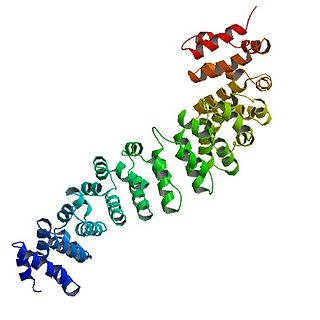
Catenin beta-1, also known as β-catenin (beta-catenin), is a protein that in humans is encoded by the CTNNB1 gene.

Myogenin, is a transcriptional activator encoded by the MYOG gene. Myogenin is a muscle-specific basic-helix-loop-helix (bHLH) transcription factor involved in the coordination of skeletal muscle development or myogenesis and repair. Myogenin is a member of the MyoD family of transcription factors, which also includes MyoD, Myf5, and MRF4.

Microphthalmia-associated transcription factor also known as class E basic helix-loop-helix protein 32 or bHLHe32 is a protein that in humans is encoded by the MITF gene.
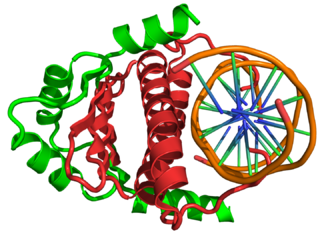
In the field of molecular biology, myocyte enhancer factor-2 (Mef2) proteins are a family of transcription factors which through control of gene expression are important regulators of cellular differentiation and consequently play a critical role in embryonic development. In adult organisms, Mef2 proteins mediate the stress response in some tissues. Mef2 proteins contain both MADS-box and Mef2 DNA-binding domains.

Forkhead box protein P1 is a protein that in humans is encoded by the FOXP1 gene. FOXP1 is necessary for the proper development of the brain, heart, and lung in mammals. It is a member of the large FOX family of transcription factors.

Transcription factor GATA-4 is a protein that in humans is encoded by the GATA4 gene.

Neurogenic differentiation 1 (Neurod1), also called β2, is a transcription factor of the NeuroD-type. It is encoded by the human gene NEUROD1.
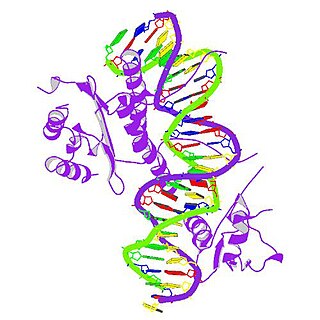
Serum response factor, also known as SRF, is a transcription factor protein.

DNA-binding protein inhibitor ID-1 is a protein that in humans is encoded by the ID1 gene.

GATA3 is a transcription factor that in humans is encoded by the GATA3 gene. Studies in animal models and humans indicate that it controls the expression of a wide range of biologically and clinically important genes.

Forkhead box C1, also known as FOXC1, is a protein which in humans is encoded by the FOXC1 gene.

Homeobox protein Nkx-2.5 is a protein that in humans is encoded by the NKX2-5 gene.
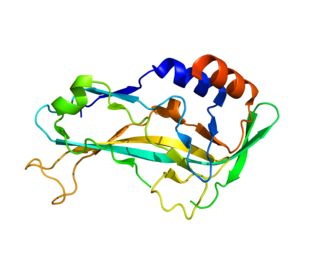
T-box transcription factor TBX5, is a protein that in humans is encoded by the TBX5 gene. Abnormalities in the TBX5 gene can result in altered limb development, Holt-Oram syndrome, Tetra-amelia syndrome, and cardiac and skeletal problems.

Hairy/enhancer-of-split related with YRPW motif protein 1 is a protein that in humans is encoded by the HEY1 gene.

Hairy/enhancer-of-split related with YRPW motif protein 2 (HEY2) also known as cardiovascular helix-loop-helix factor 1 (CHF1) is a protein that in humans is encoded by the HEY2 gene.

ID4 is a protein coding gene. In humans, it encodes for the protein known as DNA-binding protein inhibitor ID-4. This protein is known to be involved in the regulation of many cellular processes during both prenatal development and tumorigenesis. This is inclusive of embryonic cellular growth, senescence, cellular differentiation, apoptosis, and as an oncogene in angiogenesis.

Heart- and neural crest derivatives-expressed protein 1 is a protein that in humans is encoded by the HAND1 gene.

Zinc finger protein ZFPM2, i.e. zinc finger protein, FOG family member 2, but also termed Friend of GATA2, Friend of GATA-2, FOG2, or FOG-2, is a protein that in humans is encoded by the ZFPM2 and in mice by the Zfpm2 gene.

Transcription factor HES-5 is a protein that in humans is encoded by the HES5 gene.
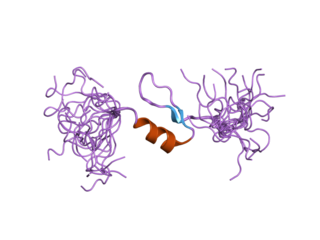
Krüppel-like factor 15 is a protein that in humans is encoded by the KLF15 gene in the Krüppel-like factor family. Its former designation KKLF stands for kidney-enriched Krüppel-like factor.
{{cite journal}}: CS1 maint: DOI inactive as of March 2024 (link){{cite journal}}: CS1 maint: DOI inactive as of March 2024 (link)This article incorporates text from the United States National Library of Medicine, which is in the public domain.